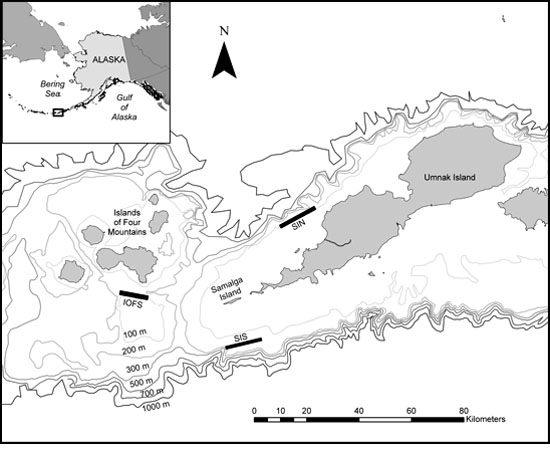

Pacific Ocean Perch Research
 Pacific ocean perch (POP) (Sebastes alutus) are an important component of Alaska groundfish fisheries, with catches of POP taken primarily from shelf breaks and gullies in the northern Gulf of Alaska and Aleutian Islands region. Pacific ocean perch are believed to spawn near the shelf break, where they release pelagic larvae that settle to a benthic existence after approximately 1 year. Pacific ocean perch may exhibit compensatory mortality during the juvenile stage resulting from concentration of strong year classes of juveniles in limited nursery habitats. Pacific ocean perch (POP) (Sebastes alutus) are an important component of Alaska groundfish fisheries, with catches of POP taken primarily from shelf breaks and gullies in the northern Gulf of Alaska and Aleutian Islands region. Pacific ocean perch are believed to spawn near the shelf break, where they release pelagic larvae that settle to a benthic existence after approximately 1 year. Pacific ocean perch may exhibit compensatory mortality during the juvenile stage resulting from concentration of strong year classes of juveniles in limited nursery habitats.
There is very little known of the specific characteristics of juvenile POP nursery habitat. In general juvenile rockfish are often associated with structured habitats, such as rocky outcrops, boulder fields, deep-water sponges and corals. Nothing is known of the costs and benefits for juvenile POP in terms of survival and growth of residing in different habitat types. If habitat limitation is a factor modulating recruitment in this species, the specific habitats used by juvenile POP need to be determined, as well as the value these habitats confer upon their residents.
In a project jointly funded by the North Pacific Research Board and the Alaska Fisheries Science Center, researchers with the Groundfish Program of the RACE Division and the Resource Ecology & Ecosystem Modeling Program of the REFM Division are assessing the value of Aleutian Islands habitat to juvenile Pacific ocean perch by:
- Applying acoustic techniques to delineate and map habitats for juvenile POP (see POP: Mapping)
- Quantifying the relationship between habitat characters and juvenile POP presence and abundance (see POP: Habitat Use)
- Determining if the condition of juvenile POP varies among habitats as an indicator of their relative health (see POP: Diet and Condition)

Map of the Samalga Pass and Islands of Four Mountains area in the Aleutian Islands showing the three study sites.
|

Herbert Island on a sunny day
from south of Chuginadak Island
|
This work was carried out in the Aleutian Islands around Samalga Pass and the Islands of Four Mountains. The field work for this project was completed in the summer of 2004. Two cruises were conducted in 2004; in May an acoustic mapping cruise was completed and in August a cruise focusing on underwater camera work was conducted. Biological samples were collected for laboratory work during both cruises. Laboratory work was completed in the summer of 2005. Currently, project principle investigators are working on statistical analysis of data and summarizing their research for publication.
|
|